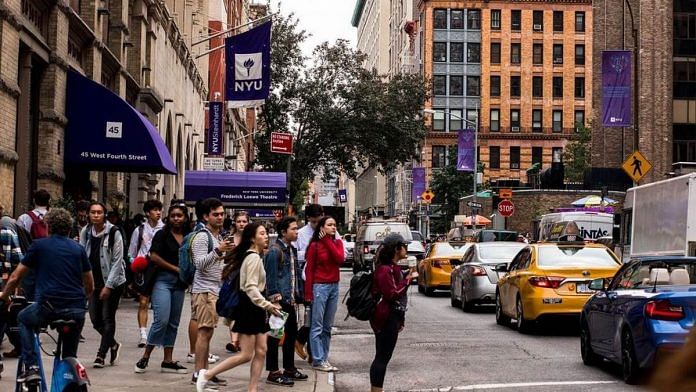New Delhi: The US has come out with a set of guidelines clarifying questions of who must pay the $100,000 fee required under the new H-1B visa lottery system as laid out in the 19 September proclamation issued by US President Donald Trump.
The latest guidelines—issued by the US Citizenship and Immigration Services (USCIS) Sunday—exempt H-1B visa aspirants from paying the $100,000 fee if they wish to change their current visa status or extend or renew their already-existing H-1B visas. Moreover, foreign students who are already in the US on F-1 visas, or intra-company transferees who are already in the US on L-1 visas, remain exempt from paying the $100,000 fee while applying for their H-1B visas.
However, for new H-1B visa petitions filed 21 September onwards, as well as applicants without a valid visa and outside the US currently, the $100,000 fee is applicable. The USCIS has already opened a portal to clear the fee, alongside new H-1B visa petitions.
In this report, ThePrint discusses why the new USCIS guidelines a relief for Indian students and global tech firms.
New guidelines bring relief to a few
The $100,000 fee has been seeing opposition within America, with the US Chamber of Commerce suing the Trump administration over its imposition.
According to the updated guidelines of the US Citizenship and Immigration Services, released Sunday, Trump’s proclamation applying the $100,000 fee “does not apply to a petition filed at or after 12.01 am Eastern Daylight Time on 21 September 2025, that is requesting an amendment, change of status, or extension of stay for an alien inside the United States, where the alien is granted such amendment, change, or extension”.
The updated guidelines added, “Further, an alien beneficiary of such petition will not be considered to be subject to the payment if he or she subsequently departs the United States and applies for a visa based on the approved petition, and/or seeks to reenter the United States on a current H-1B visa.”
Besides individuals already in the US and looking to change their status, all existing H1-B visa holders looking to extend or renew their visas are exempt from the $100,000 fee.
“The (19 September) proclamation does not apply to any previously issued and currently valid H-1B visas, or any petitions submitted prior to 12.01 am Eastern Daylight Time on 21 September 2025,” said the USCIS guidelines issued Sunday. “In addition, the proclamation does not prevent any holder of a current H-1B visa, or any alien beneficiary—following petition approval—from travelling in and out of the United States.”
The guidelines clarify that any existing visa holder or those with their petitions already approved can exit the US. When Trump first issued the proclamation, individuals had rushed to return to the US or could not leave the US until they had clarity on their visa status.
There have also been reports that the US administration may further exempt physicians, doctors, and medical staff from the $100,000 fee, but the latest guidelines do not offer any clarity in this regard.
The American Medical Association, along with at least 50 other speciality associations, has called for a waiver of the $100,000 fee for foreign professionals in these sectors.
The L-1 visa is a non-immigrant visa that enables US employers to transfer an “executive or a manager” from foreign offices to offices in the United States. It allows an employee to move to the US for an initial three years and up to seven years with extensions. According to the USCIS, a foreign national on the L-1 visa remains eligible to apply for a change in status but may not change employers.
The F-1 visa is a student visa that allows foreign nationals to study at American universities, colleges, schools, or language training institutions. India is the largest source of students at American universities, with reports indicating that nearly 3,30,000 Indians study in the US. However, since Trump has returned to the White House, the number of F-1 visas issued to Indians has seen a fall, as reported by ThePrint.
Also Read: China is the only nation gaining from Russia-Ukraine war. India must rethink multi-alignment
The bigger picture
In September, the imposition of the $100,000 fee by the Trump administration had set off a political storm within India and also triggered uncertainties among visa aspirants and companies.
Indians are the largest beneficiaries of the H1-B visa system in the US. They reportedly account for roughly 70 percent of all H1-B visas issued by the US administration. The H1-B visa system is also considered one of the assured pathways for high-skilled Indian labour to move to the US.
In the immediate aftermath of Trump’s September proclamation, US firms urged individuals on the H1-B visa to return to work immediately, particularly if they were based abroad at that time.
The imposition of potentially prohibitive fees for H1-B visas is part of the larger crackdown by the Trump administration on immigration in the US.
At least 6,000 student visas have been cancelled over the last ten months for several reasons, including overstays, while the Trump administration has deported over 1,000 Indians.
Also, the deportation of Indians on US military flights became a highly contentious issue in India, due to the images of the shackled individuals on these flights.
Indian Prime Minister Narendra Modi, during his February visit to the White House, was able to get a promise from Trump that Washington, DC, and New Delhi would create mobility frameworks for students and young professionals while cracking down on illegal immigration.
However, despite the India-US joint statement from the February meeting recognising the need for such mobility frameworks, the US President’s domestic supporters, including far-Right activist Laura Loomer, pushed for changes to the H1-B visa system to protect “American jobs”.
(Edited by Madhurita Goswami)
Also Read: Precise & proven: The Tomahawk, America’s prized missile wanted by Kyiv & feared by Kremlin






